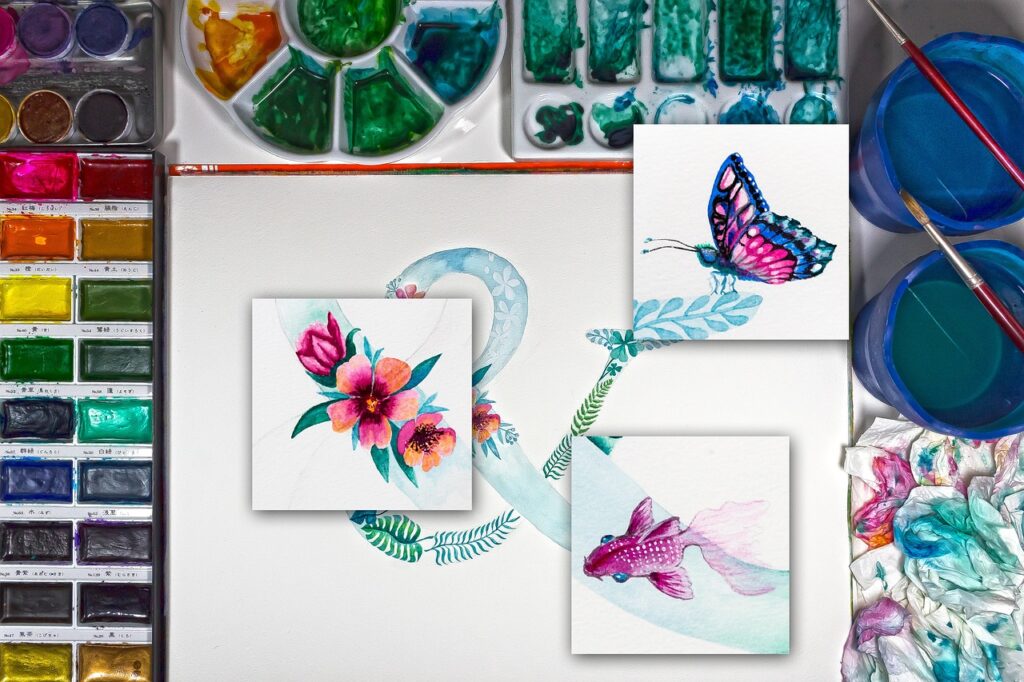
Watercoloring is a captivating art form that has enchanted artists for centuries. With its ethereal transparency and endless possibilities, it allows both beginners and experienced painters to express their creativity in vibrant, flowing compositions.
Whether you’re just starting out with easy watercolor paintings or looking to refine your skills, understanding various watercolor techniques is essential to elevating your artistry.
Let’s explore different watercolor methods and discover how to master the watercolor painting method that suits your style.
The Beauty of Easy Watercolor Paintings
For many, watercoloring might seem intimidating at first, but starting with easy watercolor paintings can help build confidence. Simple subjects like flowers, sunsets, or abstract shapes allow you to focus on learning the basics without the pressure of creating a perfect masterpiece.
One of the first things to understand about watercolor is its fluidity. Unlike acrylics or oils, watercolors move unpredictably, blending and bleeding into one another, which can create stunning effects even in the simplest compositions.
Beginners are encouraged to experiment with wet-on-dry and wet-on-wet techniques. Wet-on-dry involves applying wet paint to dry paper, giving you more control and crisp edges. On the other hand, wet-on-wet is the practice of applying wet paint onto already damp paper, allowing colors to merge organically. These are foundational watercolor methods that open up a world of creative potential.
(The Figure in Watercolor: Simple, Fast, and Focused)
Essential Watercolor Methods to Master
- Layering (Glazing) Layering is a fundamental watercolor painting method where you build up transparent layers of color to achieve depth and richness. Start with light washes and gradually add darker tones as each layer dries. This technique works wonderfully for landscapes, portraits, and botanical illustrations, where subtle shading is key.
- Dry Brush Technique For those looking to add texture and detail, the dry brush technique is invaluable. By using a brush with very little water, you can create rough, scratchy strokes that resemble the texture of wood, grass, or fabric. It’s a great way to add contrast and tactile interest to your watercolor paintings.
- Salt Technique Sprinkling salt onto wet paint can create beautiful, crystalline patterns. As the salt absorbs the moisture, it pulls the pigment with it, resulting in a natural, textured effect that’s perfect for starry skies, snowy scenes, or abstract art. This watercolor method is a favorite among artists seeking a bit of surprise in their work.
- Lifting Lifting involves removing pigment from the paper to create highlights or correct mistakes. You can use a damp brush, sponge, or even tissue paper to blot out areas of color. This technique adds dimension and can help in creating realistic lighting effects in your paintings.
- Splattering If you’re aiming for a dynamic, energetic look, splattering is the way to go. Load your brush with pigment and tap it over your painting to create random, expressive dots of color. This is an excellent watercolor method for adding spontaneity and life to your artwork.
Developing Your Personal Watercoloring Style
As you grow more familiar with these techniques, you’ll begin to develop a personal style that reflects your artistic vision.
The joy of watercoloring lies in its unpredictability — each brushstroke interacts with water and pigment in a unique way. Embrace the imperfections and let the medium guide you.
Often, the most enchanting results come from happy accidents.
Experimentation is key. Try combining techniques in a single piece — perhaps layering transparent washes over a salt-textured background, or adding fine dry-brush details to a loose, wet-on-wet landscape.
The possibilities are endless, and every experiment teaches you something new about this versatile medium.
(Watercolour for the Absolute Beginner: The Society for All Artists)
Conclusion
Watercoloring is more than just a painting method; it’s an adventure in creativity and expression. By starting with easy watercolor paintings and gradually exploring diverse watercolor methods, you can unlock the full potential of this beautiful art form.
Whether you’re layering delicate glazes, splattering bold colors, or lifting highlights to create depth, each technique brings you closer to mastering the watercolor painting method that resonates with you.
So grab your brushes, prepare your palette, and dive into the world of watercolor. Let the colors flow, and watch as your creativity comes to life on paper.
Amazon.com do great starter art kits – everything you need to get started in one bundle. Click here to view.
